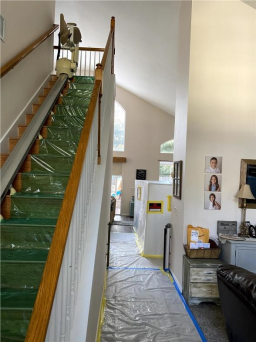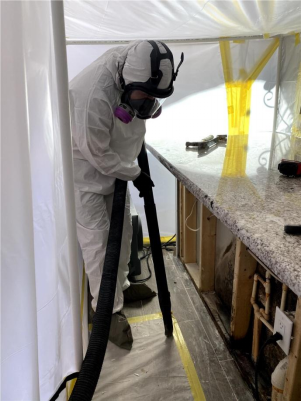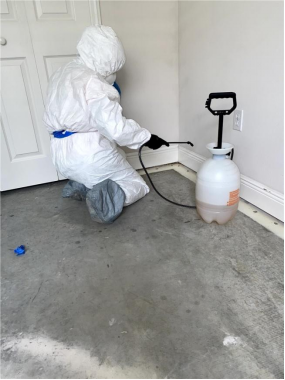
Water damage restoration is a critical process in maintaining the structural integrity and safety of your home. Whether it's due to a burst pipe, a leaky roof, or the aftermath of a storm, proper water damage repair is essential to prevent further issues such as mold growth, structural weakening, and other hazards.
Understanding the science behind water damage restoration and how to effectively dry your home can make a significant difference in the restoration process.
Water Damage
Water damage can occur from various sources, including natural disasters, plumbing failures, and appliance malfunctions. It often results in water seeping into areas where it shouldn't be, such as floors, walls, and ceilings. The primary goal of water damage restoration is to remove the water and moisture, restore the affected areas, and prevent future damage.
The Water Damage Restoration Process
The water damage restoration process typically involves several key steps:
Assessment and Inspection: Before any restoration work begins, it's crucial to assess the extent of the damage. This involves inspecting the affected areas, identifying the source of the water, and evaluating the damage to materials and structural components. Water damage restoration experts often use specialized equipment such as moisture meters and thermal cameras to detect hidden moisture and ensure a thorough assessment.
Water Extraction: Once the assessment is complete, the next step is water extraction. This involves removing standing water from the affected areas using pumps, vacuums, and other equipment. Prompt extraction is essential to prevent water from spreading and causing further damage.
Drying and Dehumidification: After the water is removed, the drying process begins. This step involves using industrial-grade dehumidifiers and air movers to dry out the affected areas. Proper drying is crucial to prevent mold growth and structural damage. The drying process can take several days, depending on the extent of the water damage and the materials involved.
Cleaning and Sanitizing: Once the area is dry, it's important to clean and sanitize to remove any contaminants and prevent mold growth. This may involve cleaning surfaces, treating affected areas with antimicrobial solutions, and removing damaged materials that cannot be salvaged.
Restoration and Repairs: The final step in the process is restoration and repairs. This involves repairing or replacing damaged materials, such as drywall, flooring, and insulation, and restoring the affected areas to their pre-damage condition. Water damage restoration experts ensure that all repairs are done to meet safety standards and building codes.
The Science of Drying
Effective drying is a critical component of water damage restoration. The science behind drying involves understanding how water interacts with different materials and using that knowledge to expedite the drying process. Key principles include:
Moisture Migration: Water moves through materials by capillary action, which is the process of water being drawn into porous materials. Understanding how moisture migrates helps water damage restoration experts determine the best methods for drying. For example, moisture can travel through walls, ceilings, and floors, requiring a comprehensive approach to drying.

Evaporation: Evaporation is the process of water turning into vapor and moving into the air. Water damage restoration experts use air movers to increase air circulation, which accelerates evaporation. Dehumidifiers are used to remove the moisture from the air, preventing it from condensing back onto surfaces.
Dehumidification: Dehumidifiers play a crucial role in the drying process by removing moisture from the air. There are two main types of dehumidifiers used in water damage restoration: refrigerant dehumidifiers and desiccant dehumidifiers. Refrigerant dehumidifiers use cooling coils to condense moisture, while desiccant dehumidifiers use chemical substances to absorb moisture. Both types are effective, and the choice depends on the specific conditions of the restoration site.
Factors Affecting Drying Time
Several factors can influence the drying time during water damage restoration:
Material Type: Different materials absorb and release moisture at different rates. For example, porous materials like wood and drywall tend to retain moisture longer than non-porous materials like metal or plastic. Understanding the material types helps water damage restoration experts determine the appropriate drying methods and equipment.
Temperature and Humidity: Temperature and humidity levels can impact the drying process. Higher temperatures can increase evaporation rates, while lower humidity levels can enhance the efficiency of dehumidifiers. Maintaining optimal conditions helps speed up the drying process and prevent additional damage.
Extent of Water Damage: The severity of the water damage also affects drying time. More extensive damage may require additional equipment and time to achieve complete drying. Water damage restoration experts assess the extent of the damage to determine the appropriate drying methods and equipment.
Storm Cleanup and Water Damage Repair
Storms are a common cause of water damage, and storm cleanup involves additional considerations. Heavy rainfall, flooding, and wind can cause significant water intrusion, requiring specialized techniques for restoration. Key aspects of storm cleanup and water damage repair include:
Emergency Response: In the aftermath of a storm, it's essential to act quickly to address water damage. This may involve temporary measures such as tarping roofs, boarding up windows, and pumping out floodwater. Quick response helps prevent further damage and reduces the risk of mold growth.
Floodwater Contamination: Floodwater can carry contaminants such as sewage, chemicals, and debris. Proper cleaning and sanitizing are crucial to ensure the safety of the affected areas. Water damage restoration experts follow strict protocols for handling contaminated water and materials.
Structural Inspection: Storm damage can affect the structural integrity of a home. A thorough inspection is necessary to identify any structural issues that may need to be addressed before restoration work can proceed. This may include checking for compromised foundations, weakened support beams, and other potential hazards.
The Importance of Professional Water Damage Restoration
While DIY methods may seem tempting, professional water damage restoration offers several advantages:
Expertise and Equipment: Water damage restoration experts have the expertise and specialized equipment needed for effective water damage repair. They understand the science of drying, use advanced tools, and follow industry standards to ensure thorough restoration.
Comprehensive Assessment: Professionals conduct a detailed assessment to identify hidden moisture and potential problems. This comprehensive approach helps prevent issues such as mold growth and structural damage that may arise from incomplete drying.
Insurance and Documentation: Water damage restoration experts can assist with insurance claims by providing detailed documentation of the damage and restoration process. This helps ensure that you receive the appropriate compensation for the repairs.

Is water damage causing problems at your property? Flood Pros USA offers rapid, same-day restoration services in Tampa, including water damage repair, mold remediation, fire damage cleanup, and flood restoration.
Our expert team is ready to handle all your needs with efficiency and care. Contact us now for reliable, professional solutions to restore your space.
Subscribe to Flood Pros USA's Blog


Comments